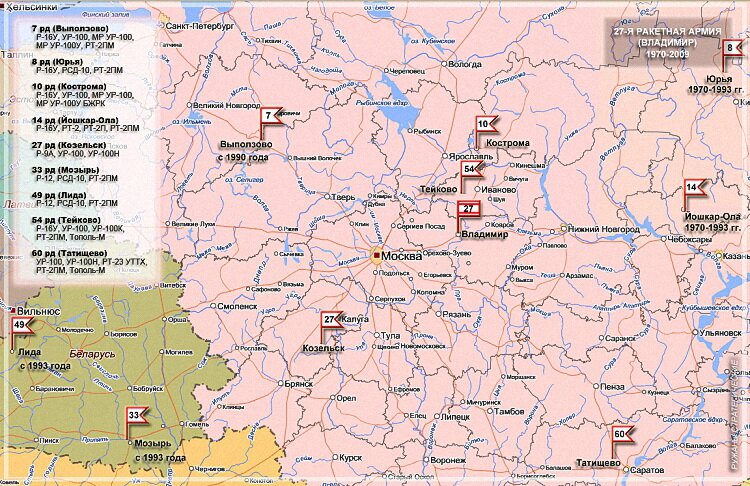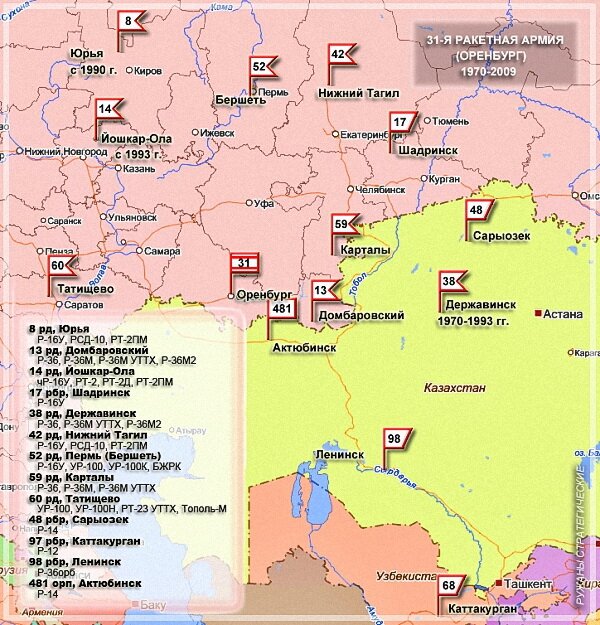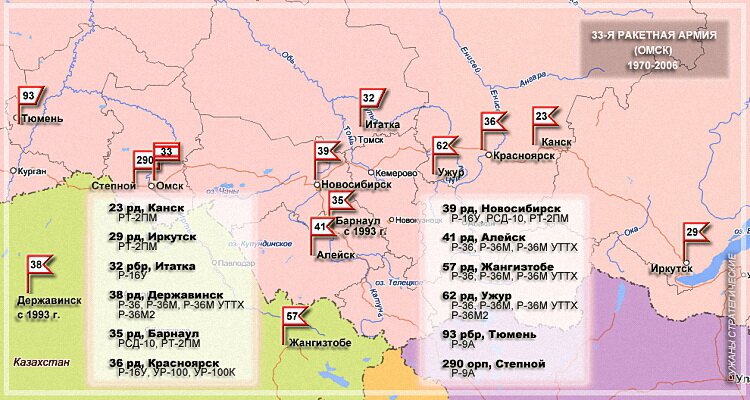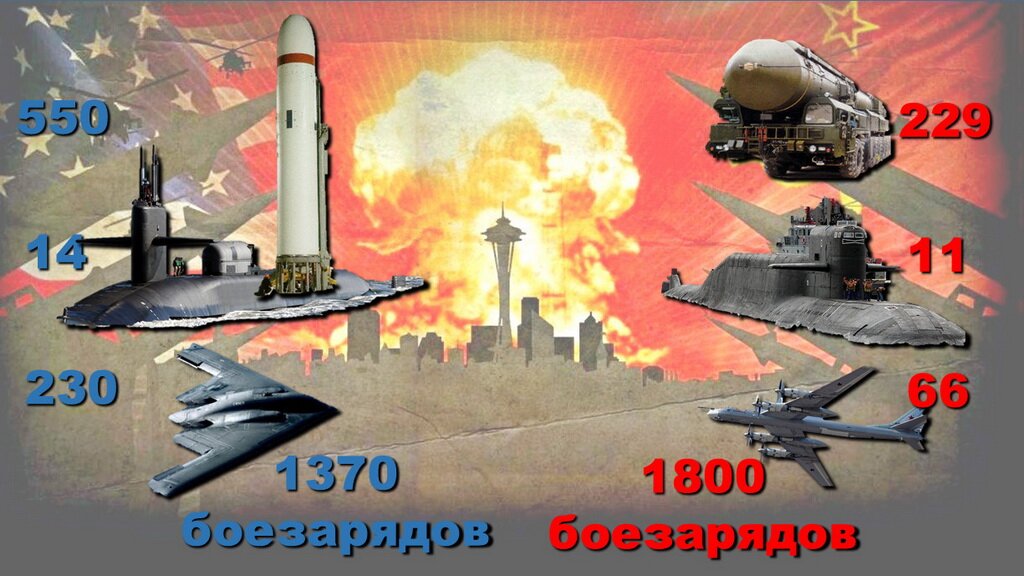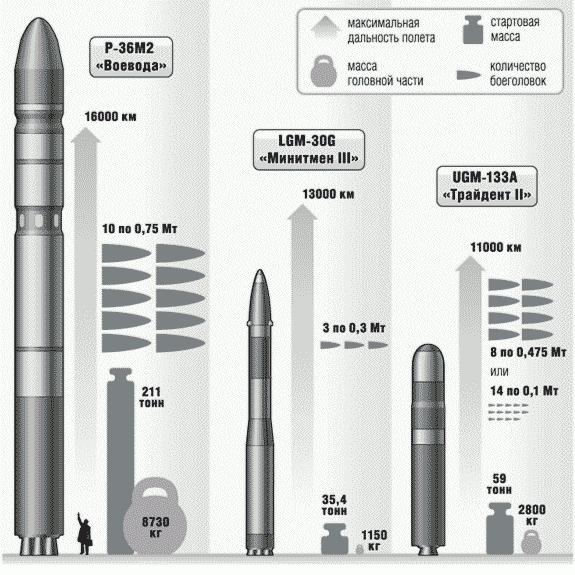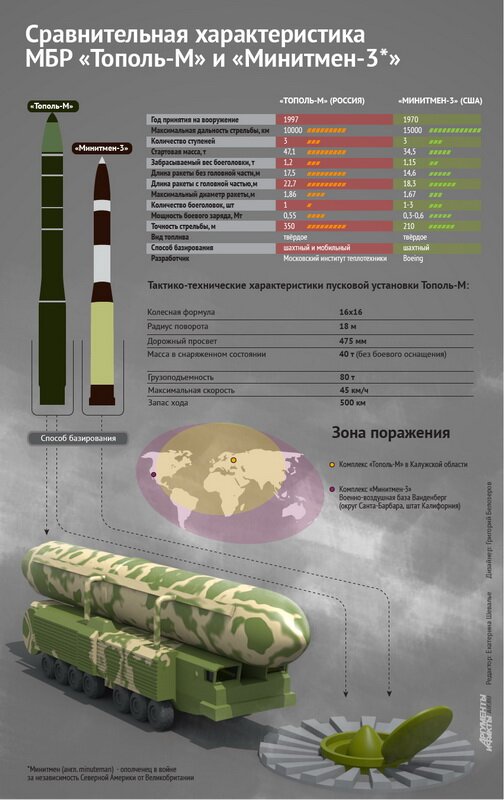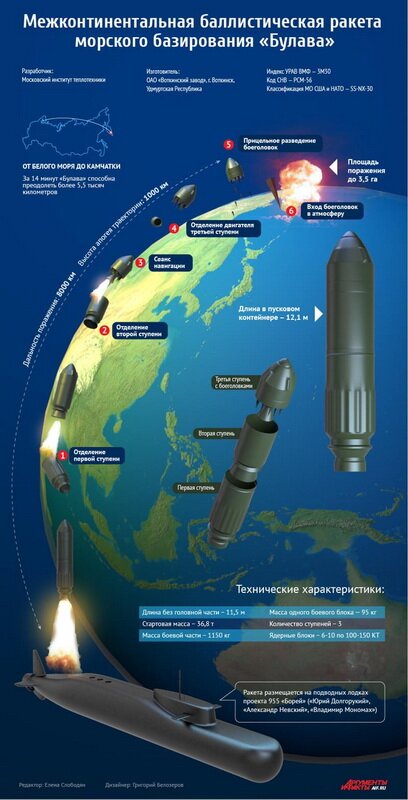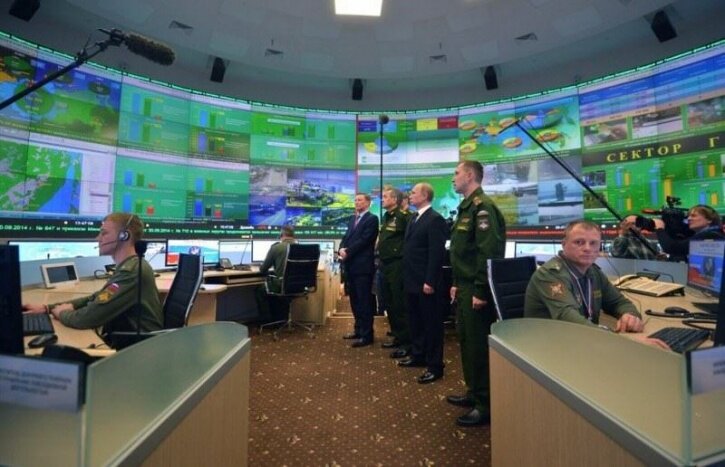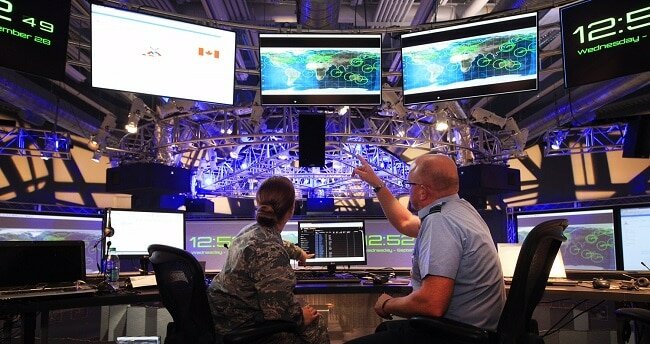
Victor Hvozd
The confrontation between the RF and the USA in the nuclear missile sphere
The aggravation of relations between Russia and the West over Ukraine is observed not only in the economic or political spheres, but also in the military one. Both Russia and the United States pay special attention to strengthening the strategic nuclear missile components of their armed forces.
For example, Russia's Strategic Nuclear Forces (SNF) have about 525 carriers, capable of carrying up to 1800 nuclear warheads. In particular, the Strategic Missile Force (RVSN) has 299 missile systems allowing to use about 900 nuclear warheads. This set includes 46 heavy missiles R-36M2 “Voevoda” (SS-18), 30 UR-100N UTTKh (SS-19) missiles, 72 “Topol” mobile missile systems (SS-25), 60 “Topol-M” silo-based complexes (SS-27), 18 “Topol-M” mobile complexes (SS-27), 63 mobile and 10 silo-deployed complexes with “Yars-M” missiles.
The Strategic Missile Force consists of three missile armies: the 27th (HQ — in Vladimir), 31st (Orenburg) and 33rd (Omsk) — all in all — 11 missile divisions.
The RF Navy has 11 strategic missile-carrying submarines with ballistic missiles on board, capable of carrying 704 nuclear warheads. There are five missile submarines of the Project 667BDRM (Delta IV/“Dolphin”) in the Northern Fleet, a total of 80 R-29RM (SS-N-23) missile launchers and one Project 955 missile submarine with 16 launchers of “Bulava” missiles. The Pacific Fleet has two missile submarines of Project 667BDR (Delta III), a total of 32 launchers of missiles R-29R (SS-N-18) and two Project 955 missile submarines.
The long-range (strategic) aviation has 66 heavy bombers, including 11 — Tu-160 and 55 — Tu-95MS. Together, they can take on board up to 462 X-55/X-55SM and X-102 cruise missiles.
Modernization of the Strategic Nuclear Forces of Russia is one of the priorities of the State Armaments Program for 2011–2020 and provides for the supply of new ground-based and sea-based missile systems. In particular, the process of arming with the new “Topol-M” and “Yars-M” missile systems (capable of overcoming the echeloned missile defense system) is under way. By the end of this year, the share of such complexes in the Strategic Missile Force is planned to be increased to 66 %.
Other missile systems are also being developed, including rail missile systems. Besides, it has been decided to resume mass production of modernized Tu-160 aircrafts in the version of Tu-160M2.
The US Strategic Nuclear Offensive Forces (SNF) have about 1370 nuclear warheads on 680 deployed strategic carriers.
It is estimated that 550 silo-based missile launchers are deployed at three US Air Force missile bases, 50 of which are for the “Minuteman III” ICBMs, 300 — for the “Minuteman-3M”, 150 — for the “Minuteman-3S” and 50 — for the “MX” ICBMs.
The naval component of the US SNF consists of nuclear submarines equipped with intercontinental ballistic missiles (SSBNs). According to experts, there are 14 “Ohio” SSBNs in combat composition, each of which has 24 “Trident-2” ICBMs. Of these, six SSBNs are based on the Atlantic coast of the United States and eight on the Pacific coast.
The aviation component of the US SNF includes strategic (heavy) B-52H, B-1B and B-2A bombers, all in all about 230 units (of which about 50 bombers are in the stored reserve). In accordance with international agreements, each of the deployed aircraft is conditionally listed as one nuclear warhead.
The leadership of the Russian Federation actively uses the power of its strategic nuclear potential to blackmail and intimidate the USA and NATO. Thus, the main thesis of statements by Russian President V. Putin, Minister of Defense S. Shoygu and other representatives of the Russian elite in the topic of confrontation between Russia and NATO is the statement about the RF Nuclear Missile Forces' readiness to deter any opponent.
More stringent and frank statements sound at the lowest level — from the mouths of individual Russian politicians, including Deputies of the RF Federal Assembly. In particular, according to State Duma's Deputy V. Nikonov's statement at the GLOBSEC-2017 international security conference in Bratislava on 28 May 2017, “...Russia will use nuclear weapons in case of the US and NATO troops' appearing in the Crimea or in the East of Ukraine.”
Such positions of the RF leadership differ greatly from the approaches of the leadership of the former USSR, which also considered nuclear weapons to be the main deterrent of the US and NATO, but refrained from frank nuclear blackmail of their opponents. The only exception was N. Khrushchev, who relied precisely on the intimidation of the West with Soviet nuclear weapons. Because of this, the Caribbean crisis arose in 1962, which almost resulted in the Third World War.
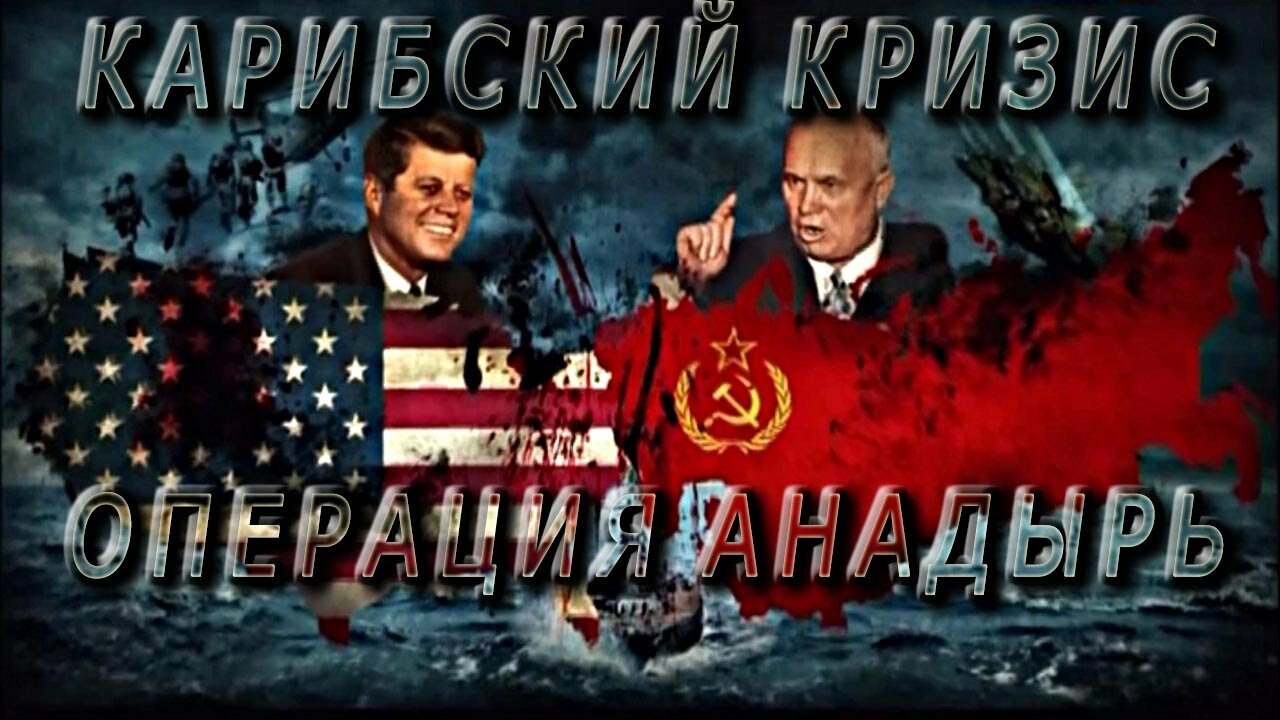
The leadership of the United States of America also pays special attention to the issues of nuclear-missile deterrence of potential enemies. Thus, the new US President D. Trump advocates the consolidation of America's nuclear superiority over other countries. Therefore, immediately after taking office in January 2017, he ordered his Department of Defense to clarify whether the US nuclear force is capable of ensuring the USA's security. The last time such an assessment was conducted seven years ago — in 2010.
By the way, in the context of threats to US strategic security, D. Trump has repeatedly mentioned Russia, as well as the superiority of its nuclear missile forces. Therefore, D. Trump has a demonstratively negative attitude to the Strategic Arms Reduction Treaty (START III, entered into force in 2011) and he sees it as the USA's concession to Russia.
Russia's and the United States' political statements on these issues, as well as their practical steps to build up their strategic nuclear capabilities, are accompanied by the intensification of the combat training of the nuclear missile components and demonstration of force.
For example, the RF Strategic Missile Force actually every month has tactical training with three to five missile regiments with combat patrolling of mobile launchers of “Topol-M” and “Yars” ICBMs. At the end of June. the most ambitious such exercises are planned with simultaneous participation of at least ten rocket regiments.
In total in 2017 it is planned to conduct about 130 command post and tactical exercises, as well as 10 combat training (test) launches of ICBMs. At this, within the framework of such various exercises and trainings involving land, air and sea components of the RF Strategic Nuclear Forces, different elements of scenarios of a nuclear missile war with the United States are mastered. In particular, in recent years, such exercises have been an invariable element of the “West” and “Caucasus” SCPEs.
Besides, the long-range (strategic) aviation of the RF AF is used in actual combat situation within the framework of missile and bomb strikes on the territory of Syria. At this, Russians launch cruise missiles that can carry nuclear weapons.
Since 2010–2011, there have been resumed regular flights of long-range (strategic) aircrafts of the RF AF — Tu-95 and Tu-160MS along the coasts of the countries of Northern Europe to the North Atlantic and towards the American state of Alaska. In some cases, these aircrafts have nuclear weapons on board, as evidenced by their radio communication with ground control.
In turn, the United States has also intensified the activities of operational and combat training with mastering issues of a nuclear missile war with Russia. The latest such event was the exercise of the United States Strategic Command (USSTRATCOM) “Global Lightning-17”, held on 7–17 February this year.
Before that, in January 2017, the US Strategic Command conducted a combat forecast of the “Bear Spear” operation to inflict a rapid nuclear strike on Russia. In turn, the US intelligence calculated the consequences of such a strike.
In parallel, the United States has resumed the practice of test launches of sea-based intercontinental ballistic missiles. Thus, on 14 February 2017, for the first time in four years, two launches of the “Trident-2” ICBMs from underwater position were carried out from the board of the class “Ohio” submarine.
The fact of the USA's building up the US Strategic Air Force in Europe is also quite eloquent. In June 2017, a group of strategic bombers B-52H, B-1B and B-2A of the US Air Force, as well as about 800 American servicemen arrived at Fairford airbase in Great Britain to participate in the exercises “Saber Strike”. For the first time since the end of the Cold War, such aircrafts began to fly over the Baltic region.
Both Russia and the United States recognize the inevitability of the catastrophic consequences of the use of nuclear weapons. Therefore, by their actions in the nuclear missile sphere, they tend, first of all, to restrain one another or to exert mutual pressure. In such circumstances, a decision to use preventive nuclear strikes can be taken solely if there is a real threat of a nuclear attack or its beginning.
Despite this, the growing confrontation between the RF and the USA increases the level of threats to strategic stability in the world, the danger of a military conflict between the parties with its subsequent development into a limited, and then full-scale nuclear missile war.
To date, the probability of such a collision is quite real, since the parties simultaneously conduct military exercises in the same areas with the use of nuclear weapons. In turn, this can lead to all sorts of incidents with unpredictable consequences.
In particular, the reason for such incidents may be Russia's actions to intercept US and NATO's military aircrafts over the Baltic Sea with dangerous rapprochement of Russian fighters. The flights of Russian long-range (strategic) aircrafts along the borders of the United States and NATO countries are also dangerous. Other emergencies, including unauthorized launches of missiles and their deviation from the course, as well as the failure of radars and computer systems of missile/air defense systems, are not ruled out. So, since the creation of missile defense systems in the USA and in the USSR, there have already been recorded about ten cases of erroneous decisions of computer systems about a large-scale nuclear missile attack by an enemy.
Against this background, the scenario of Russia's use of nuclear weapons against the USA, NATO and Ukraine is also possible as an act of “desperation” and “revenge” in case of a critical situation in the Russian Federation due to the beginning of its disintegration caused by the massive social unrest and the “sovereignty parade” of Russian regions. Alternatively, in such circumstances, the seizure of nuclear weapons by certain regional political groups or terrorists should not be excluded.
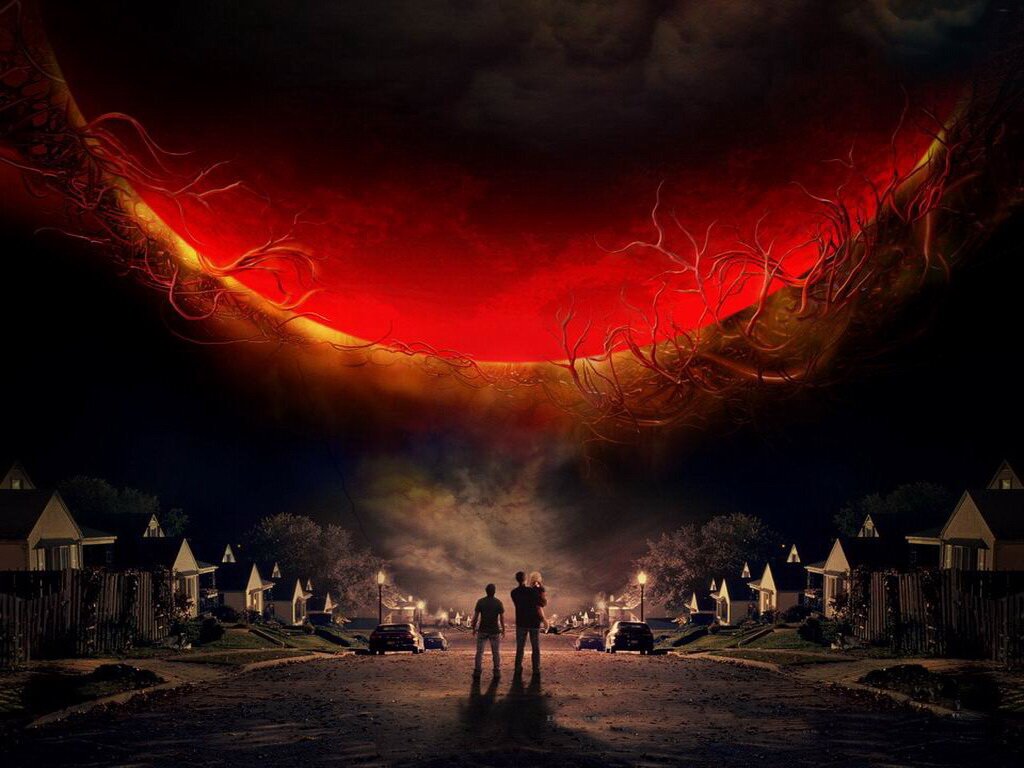 ...The world was already on the verge of a nuclear missile war...
...The world was already on the verge of a nuclear missile war...
In 1962, because of the onset of the Caribbean crisis, the world was already on the verge of a nuclear missile war. Then it was prevented through the compromise between the leaderships of the Soviet Union and the United States. The current leadership of the Russian Federation cannot in any way compromise with the West, since this would in fact mean the “political death” of V. Putin's regime. In turn, because of the position of the US Congress, US President D. Trump also would not be able to make concessions to Russia.

